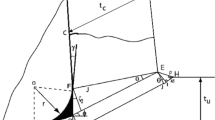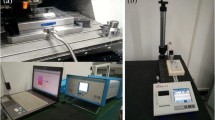Abstract
The advanced manufacturing system is aimed to produce components at right quantity, quality and cost. Turnmilling is one of the advanced machining techniques that combines turning and milling processes for high metal removal rate. In orthogonal turn milling, bottom surface of the end mill cutter removes material from the surface of a rotating workpiece. Optimization of process parameters plays an important role in machining to improve quality and productivity and reduce production cost. In the present work, an advanced teaching learning based optimization (TLBO) technique was introduced to optimize process parameters in orthogonal turn milling of Silicon Bronze. Experiments were conducted at five levels of cutting speed, feed and depth of cuts. Experimental results of surface roughness and amplitude of cutter vibration were analysed using analysis of variance. The experimental results were also used to optimize process parameters through TLBO. Experiments were also conducted using TLBO optimized process parameters and the results were compared with TLBO results. The TLBO results were found to be in good agreement with target values of the responses. Artificial neural networks were developed for the surface roughness and amplitude of cutter vibration to verify optimization.
Similar content being viewed by others
References
Milling Technical Guide. Sandvik Coromant, http://www.coromant. Sandvik.com. Accessed in May 2017
Yan R, Tang X, Peng FY, Wang Y, Qiu F (2016) The effect of variable cutting depth and thickness on milling stability for orthogonal turn-milling. Int J Adv Manuf Technol 82:765–777
Ramaswamy N (1968) Koeningsberger Experiments with Self propelled rotary cutting tools. In: Proceedings of 9th IMTDR conference, Part, vol 2, pp 945–959
Savas V, Ozay C (2008) The optimization of the surface roughness in the process of tangential turn-milling using genetic algorithm. Int J Adv Manuf Technol 37:335–340
Ren J, Zhou J, Zeng J (2015) Analysis and optimization of cutter geometric parameters for surface integrity in milling titanium alloy using a modified grey–Taguchi method. Proc Inst Mech Eng Part B: J Eng Manuf 230(11):2114–2128
Sivasakthivel PS, Sudhakaran R, Rajeswari S (2013) Optimization of machining parameters to minimize vibration amplitude while machining Al 6063 using gray-based Taguchi method. Proc Inst Mech Eng Part B: J Eng Manuf 227(12):1788–1799
Kono D, Moriya Y, Matsubara A (2017) Influence of rotary axis on tool-workpiece loop compliance for five-axis machine tools. Precision Eng 49:278–286
Ratnam Ch, Vikram KA, Ben BS, Murthy BSN (2016) Process monitoring and effects of process parameters on responses in turn-milling operations based on SN ratio and ANOVA. Measurement 94:221–232
Jalili MM, Hesabi J, Abootorabi MM (2017) Simulation of forced vibration in milling process considering gyroscopic moment and rotary inertia. Int J Adv Manuf Technol 89:2821–2836
Zahoor S, Mufti NA, Saleem MQ, Mughal MP, Qureshi MAM (2017) Effect of machine tool’s spindle forced vibrations on surface roughness, dimensional accuracy, and tool wear in vertical milling of AISI p20. Int J Adv Manuf Technol 89:3671–3679
Khalili K, Danesh M (2015) Identification of vibration level in metal cutting using undecimated wavelet transform and gray-level co-occurrence matrix texture features. Proc Inst Mech Eng Part B: J Eng Manuf 229(2):205–213
Venkatarao K, Murthy BSN, Mohanrao N (2013) Cutting tool condition monitoring by analyzing surface roughness, work piece vibration and volume of metal removed for AISI 1040 steel in boring. Measurement 46:4075–4084
Hessainia Z, Belbah A, Yallese MA, Mabrouki T, Rigal J-F (2013) On the prediction of surface roughness in the hard turning based on cutting parameters and tool vibrations. Measurement 46(5):1671–1681
Subramanian M, Sakthivel M, Sooryaprakash K, Sudhakaran R (2013) Optimization of end mill tool geometry parameters for Al7075-T6 machining operations based on vibration amplitude by response surface methodology. Measurement 46(10):4005–4022
Zhou J, Ren J, Yao C (2017) Multi-objective optimization of multi-axis ball-end milling Inconel 718 via grey relational analysis coupled with RBF neural network and PSO algorithm. Measurement 102:271–285
Rao RV, Kalyankar VD (2013) Multi-pass turning process parameter optimization using teaching–learning-based optimization algorithm. Scientia Iranica E 20(3):967–974
Rao KV, Murthy PBGSN, Vidhu KP (2017) Assignment of weightage to machining characteristics to improve overall performance of machining using GTMA and utility concept CIRP. J Manuf Sci Technol. https://doi.org/10.1016/j.cirpj.2016.12.001
Cheema MS, Dvivedi A, Sharma AK (2013) A hybrid approach to multicriteria optimization based on user’s preference rating. Proc I Mech E Part B: J Eng Manuf 227(11):1733–1742
Rao RV (2015) Teaching learning based optimization algorithm and its engineering application, Springer publishing company, 2nd chap, 1st edn. ISBN: 3319227319 9783319227313
Rao KV, Murthy PBGSN (2016) Modeling and optimization of tool vibration and surface roughness in boring of steel using RSM. ANN and SVM. J Intell Manuf. https://doi.org/10.1007/s10845-016-1197-y
Yildiz AR (2013) Hybrid Taguchi-differential evolution algorithm for optimization of multi-pass turning operations. Appl Soft Comput 13(3):1433–1439
Yildiz AR (2013) A new hybrid differential evolution algorithm for the selection of optimal machining parameters in milling operations. Appl Soft Comput 13(3):1561–1566
Yildiz AR (2013) Optimization of multi-pass turning operations using hybrid teaching learning-based approach. Int J Adv Manuf Technol 66(9–12):1319–1326
https://www.astm.org/Standards/B98.htm viewed on 10-03-2018
Rao PS, Gupta OP, Murty SSN, Rao ABK (2009) Effect of process parameters and mathematical model for the prediction of bead geometry in pulsed GMA welding. Int J Adv Manuf Technol 45:496–505
Sivaiah P, Chakradhar D (2018) Analysis and modeling of cryogenic turning operation using response surface methodology. Silicon. https://doi.org/10.1007/s12633-018-9816-1
Balaji M, Murthy BSN, Rao NM (2018) Multi response optimization of cutting parameters in drilling of AISI 304 stainless steels using response surface methodology. Proc I Mech E Part B: J Eng Manuf 232(1):151–161
Prasad Babu GHV, Murthy BSN, Rao KV, Ratnam Ch (2017) Multi response optimization in orthogonal mill turning by analysing tool vibration and surface roughness using response surface methodology. Proc Inst Mech Eng Part B: J Eng Manuf 231(12):2084–2093
Qu S, Sun F, Zhang L, Li X (2014) Effects of cutting parameters on dry cutting of aluminum bronze alloy. Int J Adv Manuf Technol 70(1–4):669–678
Taha MA, El-Mahallawy NA, Hammouda RM, Moussa TM, Gheith MH (2012) Machinability characteristics of lead free-silicon brass alloys as correlated with microstructure and mechanical properties. Ain Shams Eng J 3:383–392
Kianfar E, Shirshahi M, Kianfar F, Kianfar F (2018) Simultaneous prediction of the density, viscosity and electrical conductivity of pyridinium-based hydrophobic ionic liquids using artificial neural network. Silicon. https://doi.org/10.1007/s12633-018-9798-z
Khan A, Maity K (2018) A comprehensive GRNN model for the prediction of cutting force, surface roughness and tool wear during turning of CP-Ti grade 2. Silicon. https://doi.org/10.1007/s12633-017-9749-0
Acknowledgments
This work (Major project) was funded by Science and Engineering Research Board, Department of Science and Technology, Government of India. Grant No.: SERB/F/1761/2015-16.
Author information
Authors and Affiliations
Corresponding author
Rights and permissions
About this article
Cite this article
Rao, K.V. A Novel Approach for Minimization of Tool Vibration and Surface Roughness in Orthogonal Turn Milling of Silicon Bronze Alloy. Silicon 11, 691–701 (2019). https://doi.org/10.1007/s12633-018-9953-6
Received:
Accepted:
Published:
Issue Date:
DOI: https://doi.org/10.1007/s12633-018-9953-6




